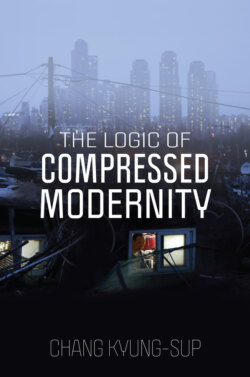Читать книгу The Logic of Compressed Modernity - Chang Kyung-Sup - Страница 11
2 COMPRESSED MODERNITY Constitutive Dimensions and Manifesting Units 2.1 Introduction
ОглавлениеIn a globally grounded comparative modernity approach, this chapter presents the formal definition, core theoretical components, and historical conditions of compressed modernity. This approach draws insights from various critical debates on complex and murky social realities in the late modern world, including postmodernism (e.g. Lyotard 1984), postcolonialism (e.g. Chakrabarty 2000), reflexive modernization (Beck, Giddens, and Lash 1994), and multiple and entangled modernities (Eisenstadt 2000; Therborn 2003). As broadly examined in the previous chapter, all of these critical debates on modernity have essential implications for the compressed modernity thesis. Compressed modernity is a critical theory of postcolonial social change, aspiring to join and learn from these critical intellectual reactions to modernity and its degenerative variations.
Compressed modernity is a civilizational condition in which economic, political, social and/or cultural changes occur in an extremely condensed manner with regard to both time and space, and in which the dynamic coexistence of mutually disparate historical and social elements leads to the construction and reconstruction of a highly complex and fluid social system (Chang, K. 2017a). Compressed modernity, as detailed subsequently, can be manifested at various levels of human existence and experience – that is, personhood, family, secondary organizations, urban/rural localities, societal units (including civil society, nation, etc.), and, not least importantly, the global society. At each of these levels, people’s lives need to be managed intensely, intricately, and flexibly in order to remain normally integrated with the rest of society.
Figure 2.1 The five constitutive dimensions of compressed modernity
Figure 2.1 shows that compressed modernity is composed of five specific dimensions that are constituted interactively by the two axes of time/space and condensation/compression. The time facet includes both physical time (point, sequence, and amount of time) and historical time (era, epoch, and phase). The space facet includes physical space (location and area) and cultural space (place and region). As compared to physically standardized abstract time–space, era–place serves as a concrete framework for constructing and/or accommodating an actually existing civilization.1 Condensation/Abridgement refers to the phenomenon that the physical process required for the movement or change between two time points (eras) or between two locations (places) is abridged or compacted (Dimensions [I] and [II] respectively). Compression/Complication refers to the phenomenon that diverse components of multiple civilizations that have existed in different eras and/or places coexist in a certain delimited time–space and influence and change each other (Dimensions [III] and [IV] respectively). The phenomena generated in these four dimensions, in turn, interact with each other in complicated ways and further generate different social phenomena (Dimension [V]).
The above schema of differentiating time and space and separating condensation and compression needs a logical justification. In a non-Western historical/social context in which Western modernity is conceived as the core source of civilizational as well as politico-military superiority, the West stands not only as a discrete region but also as a discrete (but prospectively own) moment of history. Where indigenously conscious efforts for civilizational rebirth are defeated by external forces or frustrated internally, the West often becomes both a direction for historical change (modernization) and a contemporaneous source of inter-civilizational remaking (Westernization in practice). The more condensed these changes become – that is, the faster modernization proceeds and the fuller Westernization takes place – the more successful the concerned countries tend to be considered (in spite of cultural and emotional irritations as well as political and economic sacrifices experienced by various indigenous groups). However, the very processes of modernization and Westernization endemically induce the cultural and political backlashes on the part of the adversely affected groups and, in frequent cases, systematically reinforce the traditional/indigenous civilizational constituents as these are deemed ironically useful for a strategic management of modernization and Westernization. Thereby compression becomes inevitable among various discrete temporal and regional civilizational constituents.
